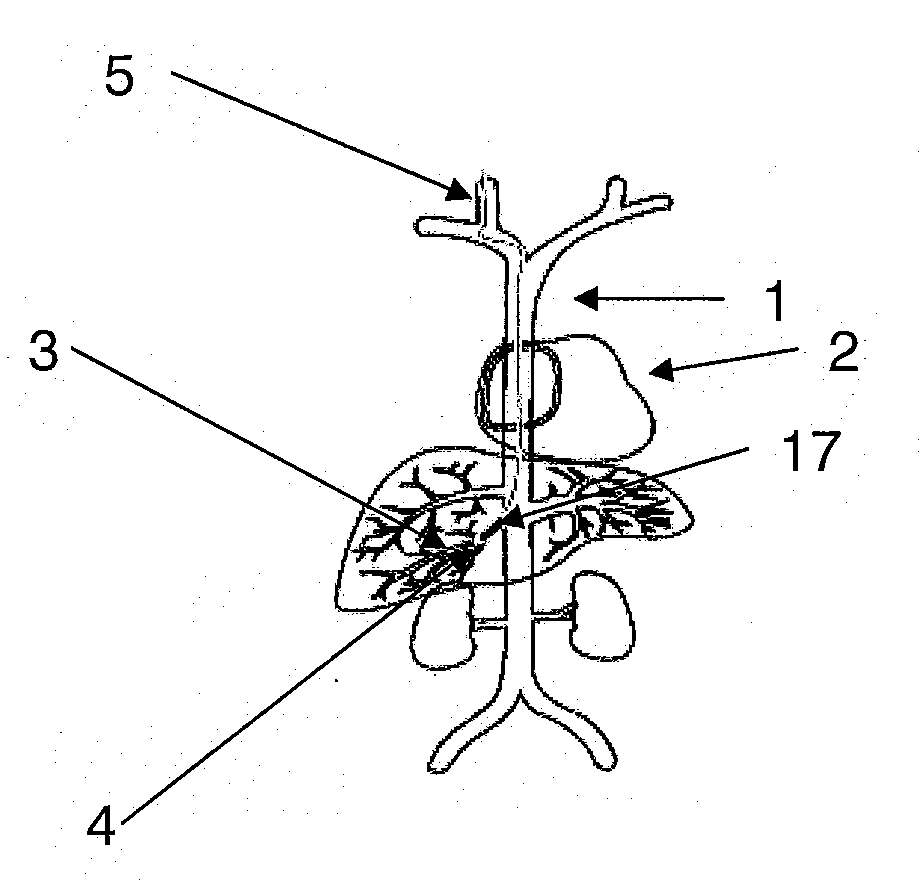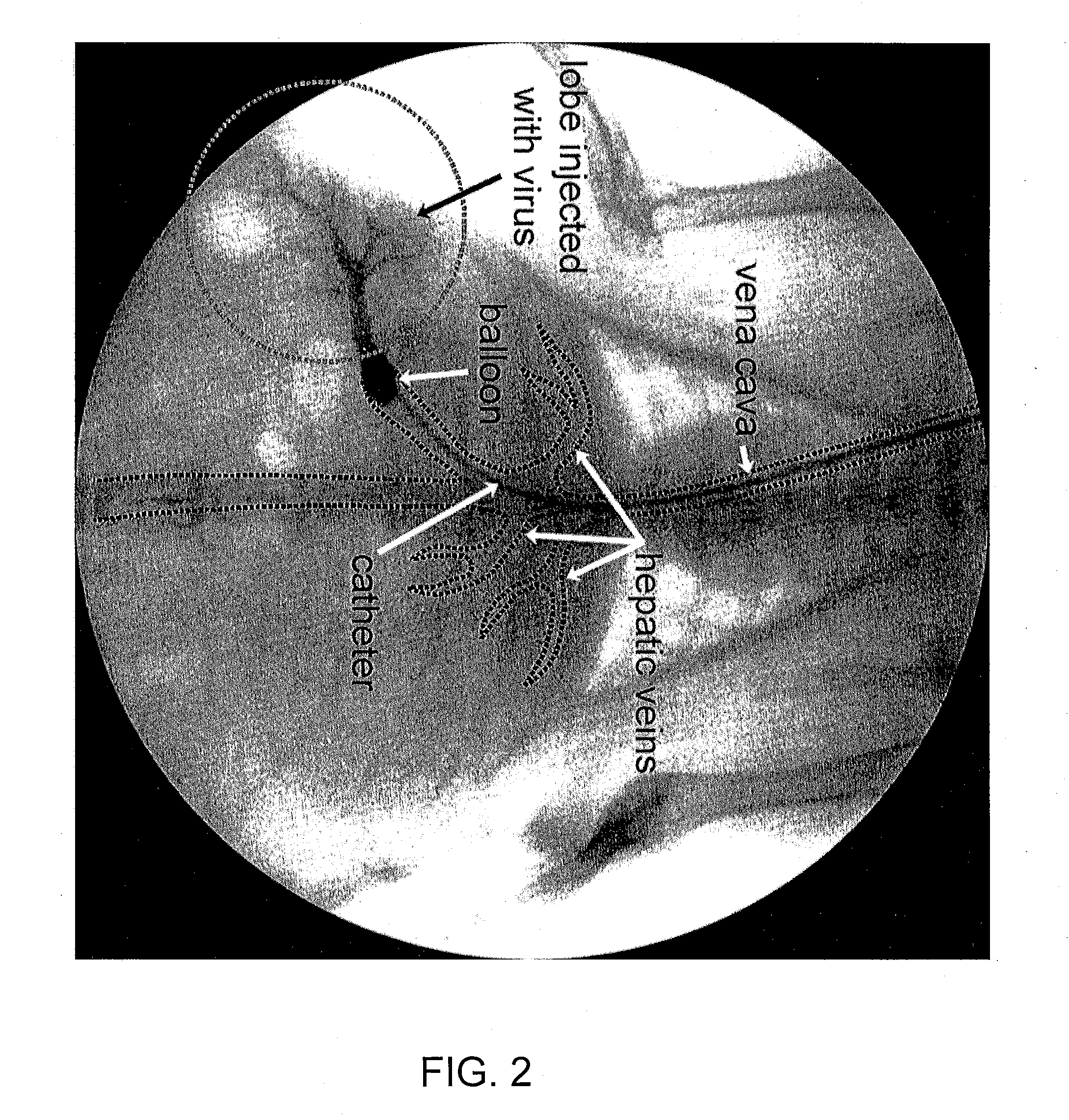Methods for targeted deliver of genetic material to the liver
a technology of genetic material and delivery method, which is applied in the direction of drug composition, biocide, metabolic disorder, etc., can solve the problems of difficult targeting specific cell types within the body, difficult to achieve targeted delivery of genetic material using viral vectors, and elevated pressure within the target organ during therapy, so as to prevent a significant rise in vascular pressure, effective gene transfer
- Summary
- Abstract
- Description
- Claims
- Application Information
AI Technical Summary
Benefits of technology
Problems solved by technology
Method used
Image
Examples
example 1
Catheter Based Delivery of an Adenoviral Gene Therapy Vector to the Rabbit Liver
[0080] For each of the experiments, New Zealand white rabbits weighing approximately 4 kg each were used (Millbrook Farms, Amherst, Mass.). The adenoviral vector utilized, Ad2βgal, has a serotype 2 backbone and is deleted of E1 but retains the E3 and E4 regions. The expression cassette consists of a cytomegalovirus (CMV) immediate-early promoter and enhancer, the cDNA for a nuclear-localized β-galactosidase, and an SV40 polyadenylation signal (Armentano, D., et al. (1997). J. Virol. 71:2408-2416). Each rabbit was injected with 1.5×1012 viral particles / kg (particle:infectious unit ratio=10:1) of the Ad2βgal virus.
[0081] Adenoviral gene therapy vector was delivered to the liver of rabbits utilizing an embodiment of the method of the present invention as follows. To access the vascular system of the rabbit, the jugular vein was exposed via a midline incision beginning at the mandibular arch and extending ...
example 2
Comparison of Local Vs. Systemic Administration in Naive Rabbits
[0096] To ask whether local delivery of a viral vector conferred an advantage over systemic delivery, Ad2βgal virus was delivered to rabbits via either 1) local delivery to the liver using the balloon catheter-mediated delivery described in Example 1 or 2) via systemic delivery using intravenous injection. Independent of delivery route, each rabbit was injected with 1.5×1012 viral particles / kg of the Ad2βgal virus.
[0097] Systemic delivery of the viral vector was carried out according to the following protocol. The marginal ear vein of a sedated rabbit was accessed using a 20-gauge angiocatheter needle secured to the ear with rolled gauze and medical tape. A luer-lock flush was attached to the catheter, and Benadryl; 1 mg / kg, IV was administered to control possible anaphylactic responses. An 8 ml volume of saline containing the Ad2βgal virus was injected into the ear vein at a rate of approximately 1 ml / sec. Localized ...
example 3
Comparison of Local Vs. Systemic Administration in Passively Immunized Rabbits
[0109] Local, catheter-mediated delivery of adenoviral vector was compared to systemic delivery in animals with anti-viral immunity to examine whether local delivery conferred an advantage over systemic delivery in this context. To accomplish this, the experiments in Example 2 were repeated in rabbits passively immunized with pooled human serum of known anti-adenoviral type 2 titers (anti-Ad2.)
[0110] One day prior to administration of virus a marginal ear vein of the sedated rabbit was accessed using a 20-gauge angiocatheter needle secured to the ear with rolled gauze and medical tape. A luer-lock flush was attached to the catheter, and Benadryl was administered intravenously (1 mg / kg) to control possible anaphylactic responses. Forty milliliters of pooled human serum (Valley Biomedical, Winchester, Va.) containing anti-Ad2 antibodies was then injected at a rate of 0.1 ml / sec. The pooled human serum had ...
PUM
| Property | Measurement | Unit |
|---|---|---|
| volume | aaaaa | aaaaa |
| total volume | aaaaa | aaaaa |
| vascular pressure | aaaaa | aaaaa |
Abstract
Description
Claims
Application Information
 Login to View More
Login to View More - R&D
- Intellectual Property
- Life Sciences
- Materials
- Tech Scout
- Unparalleled Data Quality
- Higher Quality Content
- 60% Fewer Hallucinations
Browse by: Latest US Patents, China's latest patents, Technical Efficacy Thesaurus, Application Domain, Technology Topic, Popular Technical Reports.
© 2025 PatSnap. All rights reserved.Legal|Privacy policy|Modern Slavery Act Transparency Statement|Sitemap|About US| Contact US: help@patsnap.com



